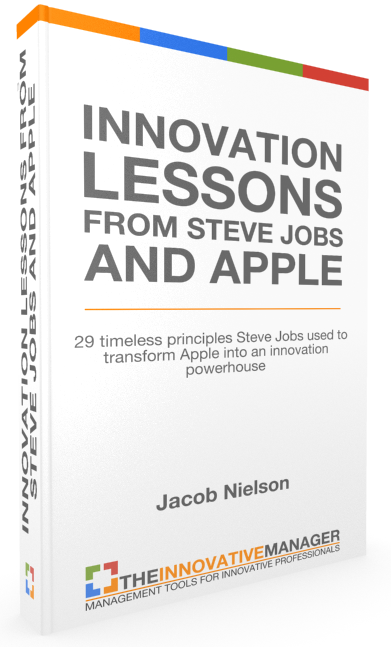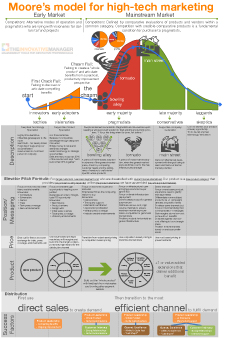The launch and subsequent success of iTunes was just the beginning of the digital hub strategy that Apple was executing. The next step was to create a portable music player that worked seamlessly with the iMac and iTunes: enter the iPod.
At the time there were a few portable MP3 players already available on the market. The problem was that most of them had serious flaws preventing them from being attractive to potential buyers. The Diamond Rio, for example, launched in 1998 but could only hold 30 minutes worth of songs. The clumsy navigation structure didn’t help either.

Diamond Rio was released in 2008 but adoption was hampered by design limitations

FREE VIDEO TRAINING FOR INNOVATORS
Over 100 Slides Free and Downloadable as a PDF
Following the Rio was the launch of the Nomad Jukebox by Creative Labs in 2000. The Nomad solved the Rio’s song capacity limitation by including a full-size hard disk drive (normally used in laptops) that could hold 6GB worth of songs (roughly 1200-1500 songs). However, because the size was so large and because it had poor battery life (it used AA’s, like the Rio), the Nomad struggled to gain adoption as well.

Creative Nomad Jukebox released in 2000 but its large size and heavy weight burdened the product from succeeding
Apple executives were well aware of the limitations of these existing MP3 players. In Walter Isaacson’s biography on Steve Jobs, he quoted Phil Schiller as saying:
“We would sit around and say ‘These things really stink’…They held about sixteen songs, and you couldn’t figure out how to use them.” – Phil Schiller
In addition to song capacity, battery life and a clumsy UI, Apple executives were keenly aware of the headache users experienced when trying to sync songs from their computer to a personal MP3 player. A host of compatibility issues around file formats (MP2, MP3, WMA, etc.) and file transfer protocols (USB 1, USB 2, parallel port, etc.) made the experience of trying to transfer songs to a portable MP3 player slow and frustrating.
This leads to the first lesson…
iPod Innovation Lesson One: Start With The Customer Experience And Work Backwards to The Technology
It is often pointed out that when Apple launched the iPod that, contrary to what many people might think, it was not the first MP3 player available on the market. Skeptics of Apple and their products would even go so far as to wonder if Apple ever really invents anything new themselves or just acts as an effective fast follower by refining existing ideas. Though these skeptics are technically right from a product or technology-centric perspective, they miss the boat on what’s really important with a new innovation – the customer experience.
The main difference between the iPod and the other existing players at the time, including the Rio and Nomad, was not the technology but the customer experience. Apple may not have invented the world’s first MP3 player but they did create the world’s first transformational customer experience with portable music. The only reason for new technology to be included in the iPod (such as the 1.8″ HDD, Firewire and lithium batteries) was to support the customer experience instead of the other way around.
In a meeting with developers shortly after Jobs returned to Apple in the late 1990’s, he explained this approach…
“One of the things I’ve always found is that you’ve got to start with the customer experience and work backwards to the technology. You can’t start with the technology and try to figure out where you’re going to sell it…And as we have tried to come up with a strategy and a vision for Apple, it started with ‘What incredible benefits can we give to the customer…Where can we take the customer?’ Not starting with ‘Let’s sit down with the engineers and figure out what awesome technology we have and how we’re going to market that.'” – Steve Jobs
Too often large organizations and even entrepreneurs, engineers and inventors can get caught in the trap of a technology-centric approach to a market in a vain attempt to succeed simply by being the first to market with that new technology. But rather than being the first to market with a new technology, history has shown that to be a poor long-term strategy, the story of the iPod teaches us that innovation success can be found in being the first to market with a new customer experience – especially when that new customer experience solves many of the drawbacks with the existing customer experience currently available from the competition.
Which leads to the next lesson…
iPod Innovation Lesson Two: Know The Competition And How To Beat Them – Especially When Entering New Markets
From their own research and personal experience, Apple executives figured out that in order to create a breakthrough customer experience around portable music, Apple would need to make a product that could achieve the following:
- Large song capacity – enough to store nearly your entire collection of CD’s (because of its size, Nomad was capable of 1,000+ songs – a high water mark at the time)
- Small enough to fit in your pocket (Nomad had a large hard drive but was too large to comfortably fit in your pocket)
- Long battery life (the Diamond Rio was capable of 8 hours, anything higher than that would have been a major improvement)
- An intuitive user interface and navigation
- A fast, simple and consistent method to transfer songs
Often organizations will refer to these kinds of lists as “Market Requirements” which basically means a list of key benefits (not features) a product must have in order to succeed in the market. These lists could also be referred to as “Customer Experience Requirements.” Prior to beginning design and engineering, having a list of these requirements is an essential step to establishing the vision for a new product development program. Once a market requirements document has been created (typically by marketing), then engineering or a cross-functional team from marketing and engineering can create the product requirements which is essentially the specifications list of technical attributes the product must have in order to meet the market requirements.
For example, to meet the above market requirements for the iPod, below are a few possible methods:
- Market Requirement: Large song capacity (Nomad was capable of 1,000+ – a high water mark at the time)
- Product Requirement: 5GB+ hard drive
- Market Requirement: Small enough to fit in your pocket (Nomad had a large hard drive but was too large to comfortably fit in your pocket)
- Product Requirement: Height x Width x Depth: 4 x 2.5 x 0.8 or smaller
- Market Requirement: Long battery life (the Diamond Rio was capable of 8 hours, anything higher than that would have been a major improvement)
- Product Requirement: 10+ hour battery life or 1200+ mAh rechargeable lithium battery
- Market Requirement: An intuitive user interface
- Product Requirement: Click-wheel navigation
- Market Requirement: A fast, simple and consistent method to transfer songs
- Product Requirement: Firewire capable
Though the market or customer experience requirements were created first, the product requirements or specs would come together over time after much exploration and research by Apple leadership. In this case Jon Rubenstein, who had successfully led development of the iMac, was tapped specifically by Jobs to lead the project.
This leads to the third lesson…
iPod Innovation Lesson Three: Recruit The Right Team and have a DRI
Because of the need for cross-functional collaboration from marketing, engineering, manufacturing, etc. sometimes the lines of accountability can be blurred and it can be hard to know who is directly responsible for the outcome of the program. This is why Apple always established what they referred to as a “DRI” which stands for “directly responsible individual.” In the case of the iPod, that individual was Jon Rubenstein.
An article from Fortune that appeared in 2011, a few months before Jobs died, talked about the DRI.
“The accountability mindset extends down the ranks. At Apple there is never any confusion as to who is responsible for what. Internal Applespeak even has a name for it, the ‘DRI,’ or directly responsible individual. Often the DRI’s name will appear on an agenda for a meeting, so everybody knows who is responsible. ‘Any effective meeting at Apple will have an action list,’ says a former employee. ‘Next to each action item will be the DRI.’ A common phrase heard around Apple when someone is trying to learn the right contact on a project: ‘Who’s the DRI on that?’ – excerpt from Fortune
As official leader of the project, Rubenstein went to work on finding the right team and the right technology to help him create the customer experience that Jobs and other senior executives demanded it achieve. His first outside recruit was a brash engineer who had worked in portable electronics at Phillips named Tony Fadell and his first technology find was a brand new Toshiba 1.8″ hard drive.
This leads to the fourth lesson:
iPod Innovation Lesson Four: Connect the Dots
One thing the Nomad had going for it was its capability of holding 1000 songs. The trouble was that the hard drive used to build the Nomad was the same hard drive that is used in laptops – which is just over 2.5″ wide.
The extra size of the hard drive led to the Nomad’s oversized case and heavy weight. For the iPod, Rubenstein wanted a way to hold 1,000 songs but without the extra weight and size associated with using a standard laptop hard drive. As far as he knew, there was no good solution for this problem.
Then a routine trip to Japan to visit Toshiba changed everything.
Walter Isaacson describes the event best in his biography of Steve Jobs…
“At the end of a routine meeting with Toshiba, the engineers mentioned a new product they had in the lab that would be ready by that June. It was a tiny, 1.8-inch drive (the size of a silver dollar) that would hold five gigabytes of storage (about a thousand songs), and they were not sure what to do with it. When Toshiba engineers showed it to Rubenstein, he knew immediately what it could be used for. A thousand songs in his pocket! Perfect. But he kept a poker face. Jobs was also in Japan, giving the keynote speech at the Tokyo Macworld conference. They met that night at the Hotel Okura, where Jobs was staying. ‘I know how to do it now,’ Rubenstein told him. ‘All I need is a $10 million check.’ Jobs immediately authorized it. So Rubenstein started negotiating with Toshiba to have exclusive rights to every one of the disks it could make.” – excerpt from Steve Jobs by Walter Isaacson

The two key takeaways from Rubenstein’s experience at Toshiba are:
- Become aware of new things
- Connect the dots between what you see and how it could help you achieve your innovation goal
If you read a lot of Steve Jobs speeches and quotes you’ll find this idea of connecting the dots come up over and over again. It seemed to be a core principle Apple relied on to foster innovation. For example, when talking about creativity with Wired, Jobs said the following:
“Creativity is just connecting things. When you ask creative people how they did something, they feel a little guilty because they didn’t really do it, they just saw something. It seemed obvious to them after a while. That’s because they were able to connect experiences they’ve had and synthesize new things. And the reason they were able to do that was that they’ve had more experiences or they have thought more about their experiences than other people.” – Steve Jobs, Wired “Steve Jobs: The Next Insanely Great Thing”
With the iPod, song capacity wasn’t the only issue solved by creativity and connecting things. When the iPod was finally released in 2001, the feature everyone was talking about after using the iPod was the scroll wheel.
According to an article in FastCoDesign.com the scroll wheel was thanks to Phil Schiller’s, Apple’s SVP of marketing, experience with a Bang and Olufsen home phone that utilized a scroll wheel for scrolling through contacts. The article explains:
“Most significantly, the BeoCom 6000 phone used sound to echo the wheel’s turns. ‘We wanted it to have sound … because we wanted to give it a tactile feeling,’ recalls Thomsen, who says Bang & Olufsen at first experimented with various materials in order to produce the hardware’s audible complement. ‘But some of the technical people came up with the idea to make the sound come from the loud speaker.'” – Apple’s Inspiration For the iPod? Bang & Olufsen, Not Braun, FastCoDesign.com
Other dots that were connected with the iPod include:
- Recognizing that FireWire rather than USB could significantly improve file transfer rates
- Noticing that a lithium ion battery common in cell phones could be used instead of AA batteries which died much faster and were generally not rechargeable
- Borrowing skip protection technology from portable CD players prevalent at the time to enable the hard drive to run only a fraction of the time the device is used (running the hard drive is a significant strain on the battery) because it would offload songs ahead in the playlist to a small flash memory buffer
No matter how challenging the innovation project is or how novel it needs to be, there are always ways to find inspiration by looking outside your own four walls by exposing yourself to the latest and greatest the world has to offer. Some of the best ways to do this are the following:
- Attend trade shows such as CES
- Read technology or forward looking magazines and blogs such as Popular Mechanics, Popular Science, Wired, TechCrunch and Engadget.
- Travel to other places or countries and observe how they do things
iPod Innovation Lesson Five: Simplify
As is common with all of Apple’s greatest innovations, the simplicity of the iPod from design to navigation to song transfer was it’s hallmark achievement. Most notably with the iPod was it’s omission of an on/off switch. Walter Isaacson explains:
“The most Zen of all simplicities was Job’s decree, which astonished his collegues, that the iPod would not have an on-off switch. It became true of most Apple devices. There was no need for one. Apple’s devies would go dormant if they were not being used, and they would wake up when you touched any key. But there was no need for a switch that would go “Click – you’re off. Good-bye.” – excerpt from Walter Isaacson’s Steve Jobs
Another example of how the iPod achieved remarkable simplicity was that it shifted complicated tasks, such as organizing playlists, to iTunes on the computer.
“In order to make the iPod really easy to use – and this took a lot of arguing on my part – we needed to limit what the device itself would do. Instead we put that functionality in iTunes on the computer. For example, we made it so you couldn’t make playlists using the device. You made playlists on iTunes, and then you synced with the device. That was controversial. But what made the Rio and other devices so brain-dead was that they were complicated. They had to do things like make playlists, because they weren’t integrated with the jukebox software on your computer. So by owning the iTunes software and the iPod device, that allowed us to make the computer and the device work together, and it allowed us to put the complexity in the right place.” – Steve Jobs
Jobs also explained his focus on simplicity to Businessweek in 1998.
“That’s been one of my mantras – focus and simplicity. Simple can be harder than complex: you have to work hard to get your thinking clean to make it simple. But it’s worth it in the end because once you get there, you can move mountains.” – Steve Jobs, Businessweek May 25, 1998
Conclusion
The iPod is one of those products that will go down in history as one of the greatest innovations of all time. By taking this behind-the-scenes look at its development and launch we can strip away the magic behind it and understand some of the key principles behind how such a breakthrough device was created and why it was so successful.
To re-cap, the story of the iPod teaches us the following principles of innovation:
- Start With The Customer Experience And Work Backwards to The Technology
- Know The Competition And How To Beat Them – Especially When Entering New Markets
- Recruit The Right Team and have a DRI
- Connect the Dots
- Simplify
Best of luck!
















